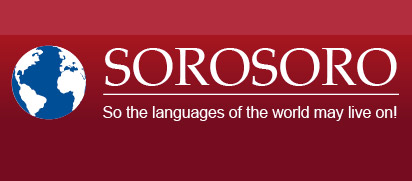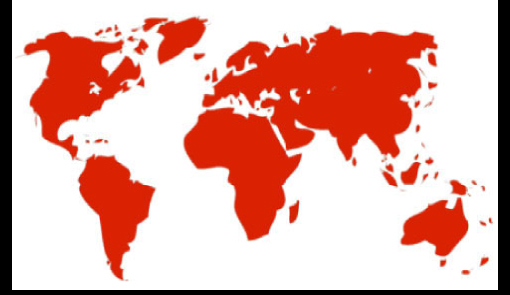Print  |
|


Indo-European Languages
Information about the Indo-European languages
Where are the Indo-European languages spoken?
The majority (approximately ¾) of the countries of the world have an Indo-European language as the sole or official language.
This phenomenon is due either to the Indo-European language being the indigenous language of the country or to the “legacy” of colonialism. The first scenario covers all but 6 European countries (Hungary, Finland, Estonia, Turkey, Georgia, and Azerbaijan), and parts of Asia: Iran, Afghanistan, India (except the southern states where Dravidian languages are spoken), Pakistan, Bangladesh and Sri Lanka. The second scenario covers sub-Saharan Africa, the entire American continent, and much of Oceania.
Thus the Indo-European languages have approximately 3 billion speakers making it the language family with the largest number of speakers in the world.
Languages or language variants in the Indo-European domain
In many European countries and the Indian subcontinent there is a delicate question which should be linguistic, but often drifts into the political arena: what is the status of forms of speech close to the official language?
Around the world, languages evolve and often diverge if the territories where they are spoken are large enough and if the contacts between different areas within these territories are isolated. Thus, over the centuries, language dialects are born (“they don’t speak like us, but we understand them”), and then with increasing historical separation mutual understanding is lost and peoples come to speak different languages of the same language family (“we don’t understand them, they speak another language”): thus Latin has evolved into French, Spanish, Italian, etc..
In the absence of a more or less centralized nation-state, dialect diversification is the rule. But when a nation-state is formed, it typically establishes an official language (and sometimes several), most often on the basis of one (or sometimes more) of the dialects spoken in its territory. Examples would include the dialects of Ile de France and the Loire Valley for French, the Tuscan dialect for Italian, and the Castilian dialect for Spanish. Compared to this official language, which becomes an obligatory point of reference for all inhabitants, other unofficial forms of speech are then easily identified. If the alternative form of speech is significantly different (e.g. in France: Basque and Breton) one can always say it is a different language, but if the alternative form of speech is very similar (e.g. in France: Picard, “Chtimi”, Gallo or Morvandiau) it may be considered to be simply a dialect variant of the same language.
In general, linguists tend to avoid a proliferation of languages. For example, most of them say that Gallo-Roman (that is to say: the result of the evolution of Latin in the greater part of what was once Gaul) is divided into three groups of dialects: the language d’Oïl, the language d’Oc (or Occitan) and Francoprovençal (or Arpitan). In this context, Picard, Walloon or Gallo of Brittany are dialects of the language d’Oïl (rather than dialects of French which is also a dialect of the language d’Oïl, but a dialect that has “succeeded”). But many activists on the ground, and even some linguists, argue for the autonomy of each type of speech and will talk of the languages d’Oïl, the Occitan languages, etc. Here we do not enter into these debates.
Nonetheless, we can still identify a number of potential cases with historical antecedents which illustrate the range of possible policies:
If two very similar dialects, even mutually comprehensible, are spoken in different countries, the most common tendency is to proclaim them to be different languages. This is what has happened with Norwegian in relation to Danish, Macedonian in relation to Bulgarian, Slovak in relation to Czech, and more recently Croatian in relation to Serbian (which are linguistically considered to be a single language). In the same vein, Afrikaans (which is a variant of Dutch from a linguistic point of view) is an official language of a sovereign state, South Africa. In this case, it is a variant that has been “normalized” and “formalized”. The opposite situation occurs in Belgium where Dutch and French are the official languages rather than Flemish and Walloon.
In some cases, the opposite strategy is adopted: as an official language an exogenous variant is selected and the local dialects are regarded as dialect variations. This is the policy chosen by German-speaking Switzerland which has German as its official language, but where widely spoken dialects of German are united under the name of Schwytzertütsch.
On the other hand, when a variant of a language is spoken on the territory of a country with another official language, there is a strong tendency to baptize it as a regional language of the country where it is spoken. This is the case in France with Alsatian and Lorraine Platt (which from a linguistic point of view are German dialects), with West Flemish (a Dutch dialect), and with Corsican (an Italian dialect). This trend is consistent with criteria of the European Charter for Regional or Minority Languages adopted by the Council of Europe in 1992. But at the time of the Revolution, for example, Alsace was considered to speak German, and Corsica to speak Italian. Writing is an area where the trend towards linguistic unity or autonomy is often best observed. For example, in Alsace written German is most often “standard” German (writing in Alsatian is more rare and newer), while Corsica has long adopted a written form which respects its special relationship to Italian to which it is linguistically very close.
Classification
Note: the languages and dialects are set in bold print and the main dialects are set in italics
Download the Indo-european languages tree (in French)
Italic Languages
Osco-Umbrian (extinct branch)
Romance Languages (Latin)
Gallo-Romance
Standard French and “Langues d’Oïl”
• Standard French
• Picard, Gallo, Normand, Burgundian, Poitou-saintongeais, Lorraine, Wallon, Franc-Comtois …
• Languedocian, Provencal
• Limousin, Auvergne, Vivaro-Alpine
• Gascon, Aranese
Catalan
• Western Catalan: North-Western Catalan, Valencian lleidatan
• Eastern Catalan: Roussillon, Central Catalan, Balearic, Alguerian.
Franco-Provençal or Arpitan
• Lyonnais, Velayen, Bressan
• Savoyard, Valle d’Aosta
• Valais, Vaud, Jura
Gallo-Italic
Gallo-Italian languages
• Piedmont, Lombardy, Liguria, Emilia-Romagna.
Ibero-Romance
Spanish
• Castilian (Standard Spanish), Andalusian
• Asturian, Leone
• Aragon
Portuguese
• Standard Portuguese
• Galician
Italo-Romance
Italian
• Standard Italian (Tuscan) and vernacular Tuscan
• Napolitan, Sicilian, Campanian, Calabrian, Corsican …
• Venetian
Sardinian
Sardinian
Rhaeto-Romance
Romansch
Friulian
Ladin
Daco Roman
Romanian
Aromanian
Celtic Languages
Goidelic
Scottish Gaelic
Manx (revitalizing)
Britonnic
Cornish (in revitalization)
• Leonard, Tregorrois, Cornish
• Vannes
Germanic Languages
Old Norse or Scandinavian Languages
Icelandic-Faroese
Icelandic
Faroese
Swedish-Norwegian-Danish
Swedish
Norwegian
Danish
Old High German
German
• Standard German
• Middle German: Franconian Rhine, Franconian Moselan, luxemburgish, thuriengian platt, platt Hesse, ripuarian …
• High German: Alemannic Alsatian, Swiss German (or schwytzertütsch), Austro-Bavarian.
Yiddish
Old Low German
Low German and East Central
• Low Franconian, Low Saxon, Low East German
Dutch
• Standard Dutch
• Flemish …
Afrikaans (derived from Dutch)
Anglo-Frisian
English
• Standard English
• Scots
Frisian
Hellenic Languages
Modern Greek
Tsakonian
Balto-Slavic languages
Baltic Languages
Latvian
Lithuanian
East Slavic
Belarusian
Ukrainian
Russian
South Slavic
Slovenian
Serbo-Croatian
• iékavien, ékavien
• tchékavien, kachkavien
Bulgarian-Macedonian
• Standard Bulgarian
• Standard Macedonian
West Slavic
Polish
• Silesian
Czech-Slovak
Czech
Slovak
Sorbian
Kashubian
Albanian
Modern Albanian
• Gheg, Tosk
Armenian
Modern Armenian
• Western Armenian, Eastern Armenian
Indo-Iranian languages
Iranian Branch
Southern Group
Pashto
Waziri
Sarikol
Yidgha
Shughni
Yazgulami
Northern Group
Ossetic
Yaghnobi
Southwest Group (Old Persian)
Persian or Farsi
Tajik
Hazaragi
Tat
Juhuru
Luri
Bakhtiari
Kumzar
Northwest Group
Dilam
Gilaki
Mazanderan
Talysh
Kurdish
Baluchi
Gorani
Zaza
Indo-Aryan branch
Maharashtra Group
Sinhala
Dhivehi
Marathi
Konkani
Pali
Maghada Group
Halbi
Oriya
Assamese
Chittagonian
Bengali
Bihari Group
Magahi
Maithili
Bhojpuri
Northwest Group
Sindhi
Potwar
Doghri
Lahnda
Punjabi
Dardic Group
Nuristani
Pashayi
Shina
Kashmiri
Bihari
Pahari Group
Nepali
Palpa
Kumaon
Garhwali
Hindustani Group
Hindi
Haryana
Urdu
Deccani
Central Group
Romani
Which Indo-European languages are in danger?
The Italic languages:
Many variants of the Languages d’Oïl are in danger as well as all of the dialects of Occitan and Franco-Provençal. Most dialects of Italian-Roman, outside Standard Italian, are threatened.
All Celtic languages are in danger with the possible exception of Welsh. Manx (extinct in the 70s) and Cornish (extinct in the 18th century) are being revitalized and now have a handful of young bilingual native speakers.
Germanic languages:
The Frankish dialects, Yiddish and Low German dialects are also in danger (with the exception of schwytzertütsch). Faroyen , the Frisian dialects, and the Scots dialect are also in danger.
The Hellenic languages:
Tsakonian is “critically endangered” according to UNESCO criteria and could become extinct.
The Balto-Slavic languages:
Sorbian and kachoubien are in danger.
Indo-Iranian Languages:
For the Iranian branch, languages threatened or endangered according to UNESCO include: Sarikol, Shughni, Yidgha, Yaghnobi, Talysh, Gorani, Yazgulami, Tat, and Kumzari with the last three being the most threatened.
For the Indo-Aryan branch, UNESCO recognizes the following languages as threatened or endangered: Nuristani, Pashayi, Garhwali, and Kumaoni.
Please do not hesitate to contact us should you have more information on this language: contact@sorosoro.org
Fact sheets available for languages in this family :








